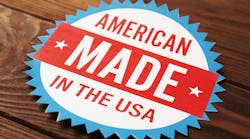Is 'Made in USA' Worth the Cost and Effort?
“Made in America.”
Years ago, this phrase used to be so simple. There was no confusion as to what it meant. Or the pride that it exuded, both to the company who made the product and the consumer who purchased it.
Things aren’t quite so simple anymore. These days, “Made in America” carries a variety of meanings. Was the entire product made in the U.S., or was it just assembled here? Was it made and assembled here but using some components from overseas? Or were the components made stateside, outsourced halfway across the world for assembly, then returned to the U.S. for sale?
Unfortunately, over the years, defining “Made in America” has become an exercise in doublespeak and obfuscation. To help clarify, in 2021 the Federal Trade Commission (FTC) finalized a new rule to crack down on marketers who make false, unqualified claims that their products are Made in the USA. Under the rule, “marketers making unqualified Made in USA claims on labels should be able to prove that their products are all or virtually all made in the United States.”
The rule did not impose any new requirements on businesses. Rather, it codified the FTC’s long-established enforcement policy statement regarding U.S.-origin claims, issued in 1997. The new policy has achieved some success in defining the Made in USA standard while also deterring companies from false misrepresentation.
So, we have a government-sanctioned definition of what Made in America means, and an enforcement policy that has more bite in pursuing those who abuse the claim. For companies that considering a homegrown approach to manufacturing, the runway has been figuratively cleared for takeoff.
But that’s only half the equation. Companies that believe embarking on the Made in USA journey is the right way to go must first ask themselves a painfully obvious question: “Why?” As in, “Why do I want to become a Made in America company in the first place?” There are certainly sound reasons to attain Made in USA certification. But while there are benefits, the tradeoff may not make it worth the effort.
Before your company begins down the Made in USA path, you need to examine some important considerations. This is not meant to convince you that one approach is better than other—just to highlight the costs and other factors that will go into making an informed decision. There are others, but here’s our own Top 10:
1. Are you willing to pay the price?
It’s almost certain that you’re going to spend more money to manufacture your product in the U.S. The main reason of course, is labor; that’s because, as it has been well-documented, labor costs in countries like China, Mexico, and others are a fraction of those in the U.S.
2. Look at all the costs, from every angle
There are myriad “counterbalancing” costs in an offshoring scenario, particularly in shipping and taxes. It will cost far less to make a component overseas, but getting it back here could very well negate those savings. Plus, if you’re getting components from a foreign location, you’ve likely already gotten a hard lesson in supply-chain issues. Pandemic or not, bringing in components or final assemblies across an ocean takes time – and lots of it. You may be paying less, but if it takes three times longer to receive your components, do you win in the long run?
3. Will your customer pay the difference – or even care?
Naturally, additional cost will need to be passed on – at least in part – to your customers. Will they be willing to shell out the extra dollars? Run a cost analysis to determine the new sale price. Made in USA makes a difference to some customers, either on principle or because of an expectation of higher quality. For others, price is the only factor. Much of this depends on the demographic and economic profile of your company’s typical customer. You might consider a customer survey to provide some guidance.
4. Will you get a better product?
It’s difficult to nail down a single answer to this question. In some but not all cases, American-made products are indeed superior. Many articles of clothing made in China are actually better than American-made versions. If you’re currently doing some offshoring of your process, you need to scrutinize your entire manufacturing operation and assess whether bringing parts of it back to U.S. soil will result in a higher-quality finished product. If not, you may be better off with the status quo.
5. Do you have the resources to do the legwork?
Some components and raw materials are easy to find on U.S. soil; others take much more effort. You—or someone on your staff—will need to spend considerable time locating these resources. The same principle applies to deciding whether to assemble in the U.S. Generally speaking, larger companies are going to have more people and internal means to execute this part of the plan. For smaller companies with fewer employees to spare—not to mention less buying power—it might not work out so well.
6. How many components are you looking to source?
Speaking of legwork, if your product consists of just 10 components, sourcing will be far less onerous than if your product needs 1,000 parts. The more parts you need, the more suppliers you need to find, which takes time and money.
7. How can you be sure you’ve found a U.S source?
You’ve spent a significant amount of time and found domestic suppliers for all of your parts. But are you sure they aren’t sourcing it themselves from overseas? Even a site visit and an investigation deeper into the supplier’s sources may not give you your answers.
8. Do you need to go all the way?
FTC standards apply to component usage, manufacturing and assembly. However, depending on the product, it’s possible to source or manufacture a small portion of components overseas, lowering costs, and still carry the Made in USA mantle – thus the “all or virtually all” standard.
9. Does it matter to you?
A company owner who sources almost everything in the U.S. can go to bed at night thinking, “I’m supporting America and I’m supporting American jobs.” What’s more, they are supporting businesses that serve the people who work for their suppliers - restaurants, gyms, supermarkets, etc. This can be a real source of pride.
10. A worker is a worker
If you’re outsourcing components, assembly, or manufacturing, you’re providing employment and sustenance for people in other countries. It can be argued that there is a humanitarian aspect at play here. Wages are lower in other countries due to a number of factors too long to list here. But with no jobs at all, wouldn’t these workers’ wages be zero?
There is no easy answer to whether you should strive for a Made in USA designation. You’ve got to figure out your priorities and decide which approach—or a combination of approaches—are best for your business.
Brandon Acker is president of Titan Abrasive Systems, manufacturer of blast rooms, blast cabinets and associated equipment. Titan sources a significant amount of its resources and components in the U.S. and can legitimately call its products “American-made.”




